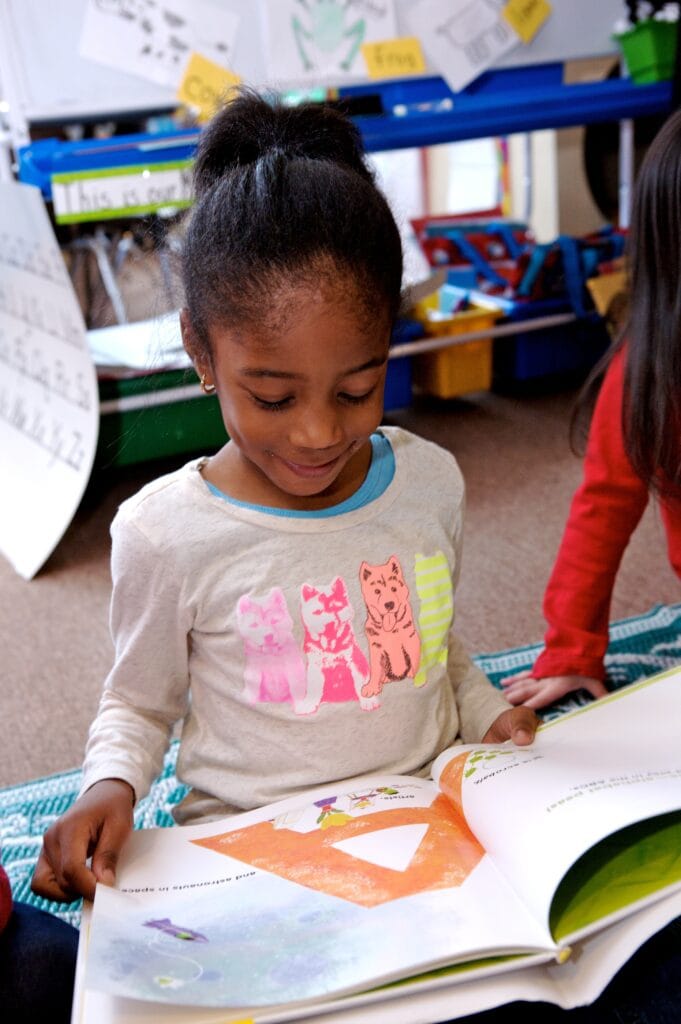


What do the following people have in common: a runner completing a marathon, a long-distance swimmer crossing the English Channel and a second grader reading for 20 minutes? Stamina, that’s what! Just as athletes train each and every day to go farther, to be stronger, and to reach their athletic goals, children need to train in their own way to reach their literacy goals. Building children’s reading stamina is one important way they can build their literacy muscles.
What is stamina?
Reading stamina is a child’s ability to focus and read independently for a period of time and is something that ideally grows over the course of time. How long children will be able to read depends, of course, on a number of factors such as their age, their access to materials that interest them, and their experience with reading. While there are no absolutely firm numbers, experts generally agree that by the middle to the end of the year, kindergartners should be able to read for up to 15 minutes, first graders up to 20 minutes, second graders up to 25 minutes, and so on. As teachers, you can help children build reading stamina in a number of ways.
Typically, classrooms tend to be task-oriented with children working on assignments such as a completing a page in a workbook or writing a paragraph about their favorite character. However, to build reading stamina, consider changing the focus from reading tasks to reading time. Help children realize that when it’s “reading time” in your classroom you expect children to do just that – spend time actively reading. Reading doesn’t end when a book or a chapter is completed; rather reading ends when the time scheduled for it is over. This slight change in mindset will help lay the foundation for lessons that teach and support active reading.
How do we help children develop stamina?
To help children build stamina, consider the space in your classroom. Just as mature readers have favorite places to read, consider how you can create inviting spaces in your classroom where children will also feel inclined to “get lost” in their books. Some children prefer sitting at their desks, others prefer to recline on the floor. Allow for differentiation in order to meet the needs of your individual learners.
In addition to space, materials are also essential to building stamina. Give the children baggies filled with all the reading materials they might need – for example, books they have chosen, pencils and post-it notes, and bookmarks with reading strategies that might help them decode unknown words. The confidence that comes with having all your “supplies” next to you allows you to remain focused on your books.
While reading is a solitary endeavor, learning can be a social activity. Consider incorporating time for reading partners to talk, share, and ask each other questions. These exchanges can allow children to re-focus on their independent reading when the time comes.
Teaching children how to select a “just right” book is essential to helping them build reading stamina as well. After all, if they aren’t interested and able to read the books they have, they are more likely to lose focus or get distracted. Help children learn how to take a “book walk” where they learn how to select a book by looking at its front and back cover, browsing through its pages, looking at the pictures and testing out the words. If the book looks interesting to them and they can read most of the words, and understand what they are reading (enough, for example, to share with someone what is happening in the story or what they are learning), then they are more likely to stay engaged. Teach children how to keep books “on deck,” that is, how to keep running lists (on paper or by heart) of books they want to read next. Also teach them to look for other books by authors or in a series they enjoy.
Children’s stamina will increase greatly if they are engaged while reading. Teach children how to make predictions, visualize, make connections, think about important ideas and ask questions. Being an active reader, a reader who “talks” back to their book, will help with engagement.
Of course, it’s quite natural sometimes to lose focus while reading. Help children learn to recognize when they have lost focus (Is your mind wandering? Are you looking away from your book more than you are looking at it? Do you remember what you just read?) and teach them how to get back on track (for example, by re-reading the last section they remember).
Because reading time is about the time spent reading and not simply about completing one chapter or a book, teach children what to do when they are done with a book. Should they write a book recommendation and post it where their friends can see it? Should they put post-it notes in the book on pages that they want to talk to their reading partner about? Should they begin a new book right away? Consider the needs and interests of the students in your class as you begin to offer your readers options for what to do when they finish a book in order to help them build their stamina. Talk about some of these options and make an anchor chart together as a class. Place the chart somewhere children can easily reference it during reading time, such as the library corner. For some anchor chart examples and inspiration, check out CLI on Pinterest!
The more stamina children have while reading, the more success they will have as readers. The joys of being lifelong readers await!


Join CLI’s Breakfast Briefing to explore the future of literacy! Connect with education leaders, hear impact stories, and discover ways to get involved. Stay[..]

Empower Oregon’s educators with proven literacy strategies! Join our free virtual info session to explore research-based tools and connect with experts. Register now!

Celebrate Women's History Month with powerful stories that inspire, educate, and uplift. 📚 Download our curated guide and stay connected for more inclusive literacy[..]